-

新人教版高中英语必修2Unit 4 History and Traditions-Discovering Useful Structure教案一
Step 5 Practice一、完成下列句子。1. Judy and I _______________(把车停下来(park))in an underground car Park near Trafalgar Square, where we could ______________________(让我们的车充电(charge)).2. When we finally reached the service desk to ask for audio guides, we heard it ___________ that there were no audio guides____________(留下,剩下).3. We__________________________(发现自己对...很惊讶)the large number of visitors and the amount of noise at the entrance of the National Gallery.4. Judy ____________________(眼神专注于) Van Gogh’s Sunflowers. It was hard to approach the painting as there were so many people around.5. She ____________________(把这幅画的复制品装箱(box)) to ensure that it was delivered safely.答案:1.had our car parked get our car battery charged 2. announced left 3. found ourselves very surprised 4. had her eyes fixed on 5. had a copy of the painting boxed二、用过去分词对下列句子进行改写。1. Loch Ness was surrounded by beautiful natural landscape, which made it look amazing.2. Carl and his friend stayed with a generous family who offered them bread with butter and honey that was homemade.3. The family’s ancestors once attended to soldiers who were wounded in the First World War.4. The young people were attracted by the legend of Loch Ness. They watched over the lake with their cameras and binoculars, which were positioned on the hill.答案:1. Loch Ness surrounded by beautiful natural landscape looks amazing.2. Carl and his friends stayed with a generous family who offered them homemade bread with butter and honey.3. The family’s ancestors once attended to wounded soldiers in the First World War.4. The young people attracted by the legend of Loch Ness watched over the lake with their cameras and binoculars positioned on the hill.

新人教版高中英语必修2Unit 3 The Internet-Reading and Thinking教案一
Paragraph 3. Jan decided to start an IT club to teach old people how to use computers and the Internet. Paragraph 4. Jan has started taking online classes to learn more about how to use the Internet to make society better. Paragraph 5. Jan’s life has been greatly improved by the Internet. Step 5: Critical thinking:(1)How do you arrange your time spent on study and the Internet? Is it reasonable? I usually surf the Internet using my mobile phone for only an hour after class, and it is reasonable for me.(2)What are your online activities? Are they safe? I chat with my friends, read news and play games. I never give away my private information so I think they are safe.Step 4: summary Much has been written about the wonders of the World Wide Web. There are countless articles (1)______(tell) us how the Internet has made our lives more convenient. But the Internet has done a lot (2)_____(much) for people than simply make life more convenient. People’s lives (3) _________________(change) by online communities and social networks so far. Take Jan for example, who developed a serious illness that made her (4)_____(stick) at home with only her computer to keep (5)___(she) company. She joined an online group (6)______ she could share problems, support and advice with others. She considered the ability to remove the distance between people as one of the greatest (7)_______(benefit). She was so inspired (8)____ she started an IT club in which many people have been helped. She has started to learn more about how to use the Internet to make society better. Her next goal is to start a charity website to raise money (9)___ children in poor countries. Jan’s life has been (10)______(great) improved by the Internet. Step 5 Homework:Review what we have learned and find out the key language points in the text.

新人教版高中英语必修2Unit 4 History and Traditions-Listening&Speaking&Talking教案一
This unit is about history and traditions. From the opening page, we can know that this unit will introduce the history and traditions around the world. As Marcus Garvey says “A people without the knowledge of their past history, origin and culture is like a tree without roots”, it is important for students to realize the importance and value of knowing the history and traditions and their further meanings. And this part ( listening and speaking ) is divided into two parts: Part A---share views on historic sites, Part B ---talk about a visit to a historic tourist destination. By talking with a foreigner, the speakers introduce the historic attractions and their cultures. Part A is that William, a British student, who was going to visit the Confucius Temple and a Chinese student, Xiao Kong, who was going to the Confucius Temple to meet with the members of the research group, went together and exchanged their views on the Confucius Temple, Confucius, Confucius' descendants and Confucius' educational thoughts. Part B is a conversation between Xiao Yan, a youth hostel receptionist and Paul, a backpacker about the feelings and experience after visiting the Chinese famous tourist attraction Pingyao.1. Guide students to understand the content of listening texts in terms of the whole and key details; 2. Cultivate students' ability to guess the meaning of words in listening; discuss with their peers how to talk about historic spots and great person.3. Instruct students to use functional sentences of showing one’s excitement, surprise and disappointment.1. Guide students to understand the content of listening texts in terms of the whole and key details; 2. Cultivate students' ability to discuss with their peers the related topics.3. Enable students to use the functional items of showing one’s excitement, surprise and disappointment.

新人教版高中英语必修2Unit 3 The Internet-Reading For Writing教案一
⑦identity theft 身份盗窃⑧chat room 聊天室⑨draft your blog post 起草博客帖子⑩post embarrassing photos 张贴尴尬照片 【话题句式】 1. How do you stay safe online and avoid bad experiences on the Internet? 你如何在网上保持安全, 避免在网上的不良经历? 2. I’m not an expert, but many years as a blogger have taught me a thing or two. 我不是专家, 但作为一个博主, 我已经学了好几年了。 3. If you see or read something that makes you feel uncomfortable, leave the site immediately. 如果你看到或读到一些让你觉得不舒服的东西, 立即离开这个网站。4. Don’t give out your address or phone number. 别告诉别人你的地址或电话号码。 5. Identity theft is a common and serious problem. 身份盗窃是一个常见而严重的问题。6. Being online is no excuse for being rude, and you don’t want to become a target for a troll or cyberbully. 上网并不是无礼的借口, 你也不想成为发挑衅帖子的人或网络恶霸的目标。 7. Trolls often use several false names so that they can stay on a site. 发挑衅帖子的人经常使用几个假名, 这样他们就可以留在一个网站上。8. However, the more polite you are, the less likely it is you will be attacked. 然而, 你越有礼貌, 你被攻击的可能性就越小。

新人教版高中英语必修2Unit 4 History and Traditions-Reading and Thinking教案一
Features of languages1.Finally, in the 20th century, the southern part of Ireland broke away from the UK, which resulted in the full name we have today: the United Kingdom of Great Britain and Northern Ireland.该句是一个复合句。该句主句为:the southern part of Ireland broke away from the UK;which resulted in the full name we have today为which引导的定语从句代指前面整句话的内容,we have today为定语从句修饰先行词name。译文:最后,在20世纪,爱尔兰南部脱离英国,这导致了我们今天有的英国的全名:大不列颠及北爱尔兰联合王国。2.Almost everywhere you go in the UK, you will be surrounded by evidence of four different groups of people who took over at different times throughout history.该句是一个复合句。该句主句为:you will be surrounded by evidence of four different groups of people;其中Almost everywhere you go in the UK为让步状语从句; who took over at different times throughout history为定语从句修饰先行词people。译文:几乎无论你走到英国的任何地方,你都会发现历史上有四种不同的人在不同的时期统治过英国。3.The capital city London is a great place to start, as it is an ancient port city that has a history dating all the way back to Roman times.该句是一个复合句。该句主句为:The capital city London is a great place to start; as it is an ancient port city that has a history dating all the way back to Roman times.为原因状语从句;dating all the way back to Roman times为现在分词短语作定语修饰history。

新人教版高中英语必修2Unit 5 Music-Discovering Useful Structures教案一
Step1:自主探究。1.(教材P52)Born(bear) in the USA on 2 January 1970, Whitacre began studying music at the University of Nevada in 1988.2.(教材P52) Moved(move) by this music, he said, “It was like seeing color for the first time.”3.(教材P56)I was very afraid and I felt so alone and discouraged(discourage).4.(教材P58)Encouraged(encourage) by this first performance and the positive reaction of the audience, I have continued to play the piano and enjoy it more every day.Step2:语法要点精析。用法1:过去分词作表语1).过去分词可放在连系动词be, get, feel, remain, seem, look, become等之后作表语,表示主语所处的状态Tom was astonished to see a snake moving across the floor.汤姆很惊讶地看到一条蛇正爬过地板。Finally the baby felt tired of playing with those toys.终于婴儿厌倦了玩那些玩具。注意:1).过去分词作表语时与被动语态的区别过去分词作表语时,强调主语所处的状态;而动词的被动语态表示主语是动作的承受者,强调动作。The library is now closed.(状态)图书馆现在关闭了。The cup was broken by my little sister yesterday.(动作)昨天我妹妹把杯子打碎了。2)感觉类及物动词的现在分词与过去分词作表语的区别过去分词作表语多表示人自身的感受或事物自身的状态,常译作“感到……的”;现在分词多表示事物具有的特性,常译作“令人……的”。
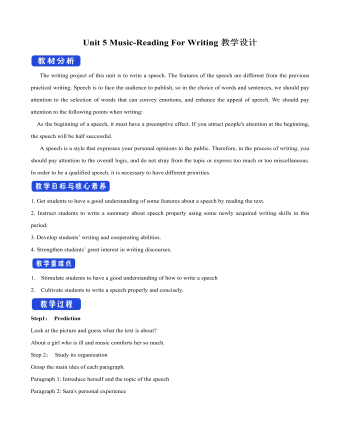
新人教版高中英语必修2Unit 5 Music-Reading For Writing教案一
(4)Now we have heard a number of outstanding speeches ... 我们已经聆听了许多精彩的发言……(5)Because we wanted the nations of the world, working together, to deal with ... 因为我们希望全世界各国团结起来去应对……(6)And if we do not act ... 如果我们不采取行动……(7)Now, I share the concerns that have been expressed ... 我也同意对于……表达的担心(8)Let us show the world that by working together we can ... 让我们告诉全世界,通过一起努力我们可以……(9)It is now time for us to ... 是时候我们……(10)And I have always wished that ... 我一直希望……(11)Thank you for letting me share this day with me.感谢你们和我共度这一天。实践演练:假如你是高中生李华,你校将举办一次以“音乐”为主题的演讲比赛,请你按照主题,写下你的演讲稿。注意:词数100左右。First of all, thank you for listening to my speech. My topic is: love music like love yourself.Music is like the air we need to maintain our normal lives around us. You can't imagine how terrible a world without music would be. Movies and TV shows have no music, only dry conversations and scenes; mobile phones only vibrations; streets only noisy crowds; cafes, western restaurants only depressed meals. What a terrible world it is!As a student, I hope we all can enjoy the fun brought by music in our spare time. Instead of just listening to music, we can even make our own music. Let's enjoy the fun of music!Thanks again for your attention!
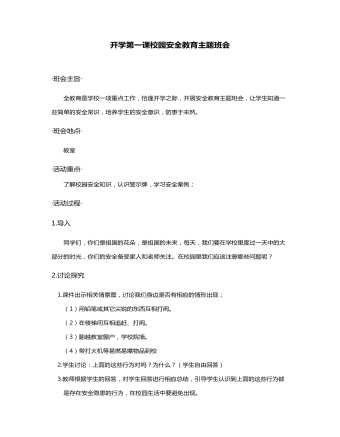
开学第一课安全教育主题班会教案
教师出示相关校园安全知识。(1)食品安全a. 不到没有卫生许可证的小摊贩处购买食品,选择新鲜和安全的食物;注意查看食品的保质期限、配方等安全信息。b. 养成良好的卫生习惯,饭前洗手。 c. 彻底洗净蔬果;不吃霉变的食物;不吃生食;尽量不吃剩菜剩饭。d. 保持健康的饮食习惯,不把饮料当水喝,不吃烧烤、油炸、烟熏及膨化食品,注意三餐定时定量。(2)人身安全 a.有序进出教室,上下楼梯靠右行,不拥挤或互相推搡。 b.在校园追跑打闹。不爬学校的围墙,门窗、围栏、树木、球架。 c.课外活动和体育锻炼,要按有关安全规则进行。在往返家校的路上,要注意交通安全,行路要严格遵守交通规则。 d.不得携带管制刀具,违禁物品进校园。(3)消防安全 a.不携带易燃、易爆、有毒物品等进入校园。 b.若插座、照明灯、电风扇等电器发生故障,不得私自动手排除,应报告教师或总务处,由学校电工进行故障排除。
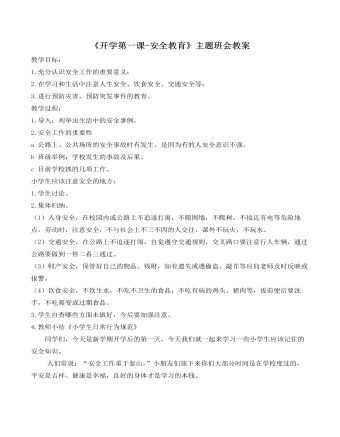
《开学第一课-安全教育》主题班会教案
教学目标:1.充分认识安全工作的重要意义;2.在学习和生活中注意人生安全、饮食安全、交通安全等;3.进行预防灾害,预防突发事件的教育。教学过程:1.导入:列举出生活中的安全事例。2.安全工作的重要性a 公路上、公共场所的安全事故时有发生,是因为有的人安全意识不强。b 班级举例:学校发生的事故及后果。c 目前学校抓的几项工作。小学生应该注意安全的地方:1.学生讨论。2.集体归纳。(1)人身安全,在校园内或公路上不追逐打闹,不爬围墙,不爬树,不接近有电等危险地点,劳动时,注意安全,不与社会上不三不四的人交往,课外不玩火,不玩水。(2)交通安全,在公路上不追逐打闹,自觉遵守交通规则,交叉路口要注意行人车辆,通过公路要做到一停二看三通过。

大班社会教案:从古到今话交通(一堂公开课)
二、课前准备:1、在教师的指导下,让同学们按自己的兴趣,分成六个小组,参考教材提示的相关内容的学习方法搜集资料。分组情况:陆上交通小组(一至四组):分别查找有关路、桥、陆上交通工具(自行车组、机动车组)发展变化的资料。水上交通小组:查找有关船的发展变化的资料。空中交通小组:查找有关热气球、飞艇、飞机等飞行器发展变化的资料。 2、教师准备相应课件与资料。

人教版高中政治必修1第一课神奇的货币教案
1、外汇与外币的关系:(1)外汇包括外币,但外汇不等于就是外币。外币是指外国的货币,包括外国的纸币、铸币;外汇通常是以外国货币表示的用于国际间结算的支付手段,具体包括外币、外币有价证券、外币支付凭证等。(2)外币属于外汇的范围,但不能把二者等同起来。通常情况下,只有可以自由兑换的外币才是外汇,因为外汇的实质是国际支付手段,如果某种货币不能自由兑换,它就不能成为国际支付手段。外汇执行的 主要是货币的支付手段的职能。(3)持有外汇意味着对外汇发行国拥有债权。持有外汇过多,一方面意味着国际支付能力强和有可能对外汇发行国施加影响;另一方面则意味着大量该由本国享受的资源,被借给外国利用,并要承担外汇贬值的风险。2、关于币值变化的分析:(1)对货币升值的具体分析:一个国家的货币升值(上浮)后,同量的这种货币能比以前换 取更多的他国货币,买到更多的他国商品。
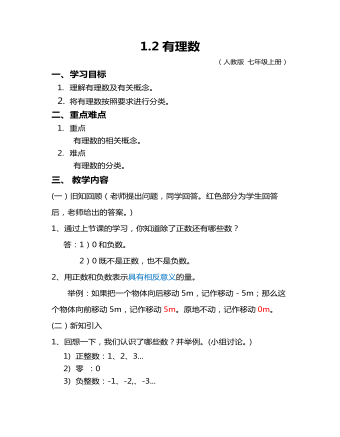
有理数教案
(一)旧知回顾(老师提出问题,同学回答。红色部分为学生回答后,老师给出的答案。)1、通过上节课的学习,你知道除了正数还有哪些数?答:1)0和负数。2)0既不是正数,也不是负数。2、用正数和负数表示具有相反意义的量。举例:如果把一个物体向后移动5m,记作移动-5m;那么这个物体向前移动5m,记作移动5m。原地不动,记作移动0m。
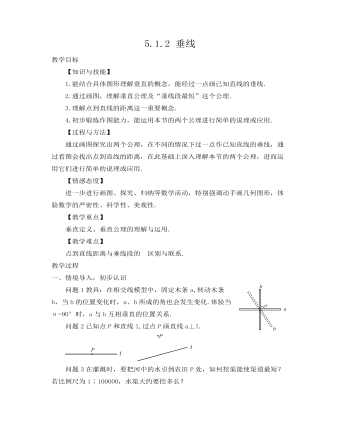
垂线教案
教学目标【知识与技能】1.能结合具体图形理解垂直的概念,能经过一点画已知直线的垂线.2.通过画图,理解垂直公理及“垂线段最短”这个公理.3.理解点到直线的距离这一重要概念.4.初步锻炼作图能力,能运用本节的两个公理进行简单的说理或应用.【过程与方法】通过画图探究出两个公理,在不同的情况下过一点作已知直线的垂线,通过看图会找出点到直线的距离,在此基础上深入理解本节的两个公理,进而运用它们进行简单的说理或应用.【情感态度】进一步进行画图、探究、归纳等数学活动,特别强调动手画几何图形,体验数学的严密性、科学性、美观性.
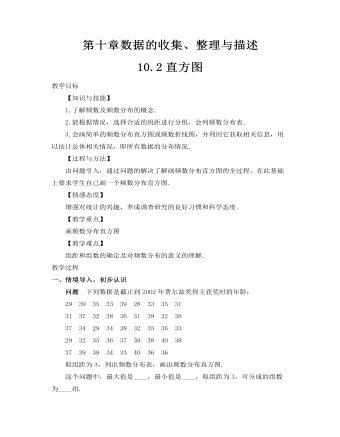
直方图教案
师生互动,课堂小结1.画频数分布直方图的一般步骤:(1)计算最大值最小值的差;(2)决定组距与组数;(3)列频数分布表;(4)画频数分布直方图.2.直方图与条形图的区别:直方图的各长方形通常是连续排列中间没有空隙,长方形的宽表示各组距,高表示频数,它反映的是数据的分布情况;条形图一般不连续排列,中间一般有间隙,长方形的高表示频数,宽没有什么特殊的意义,只表示数据的一种类别.3.频数折线图的各点的位置:起点是向前多取一个组距,在横轴上取这个组距的中点即可,中间各点取各小长方形顶部宽的中点(组中值),末点是向后多取一个组距,在横轴上取这一个组距的中点即可.

猜字谜教案
课后反思:由于学生已初步具备认读生字的能力,教学时我把主动权交给学生,有利于调动学生识字的积极性和创造性,培养学生识字的能力。再者,我严格要求学生按照笔画顺序来书写,同时还注意充分发挥学生学习的主动性与创造性,鼓励他们运用各种方法来识记生字。另外学生边说笔画名称边书空,增加学生对生字的记忆力,然后我对关键笔画进行点拨,最后让学生描红、临写。我在巡视过程中适当指点,并给学生写得好的字画个小红星,这对学生起到较大的激励作用。我在学生猜谜底时通过表演的形式,不仅激发了学生的兴趣,还能给学生更加形象生动的视觉刺激,会教学目的很好的完成。
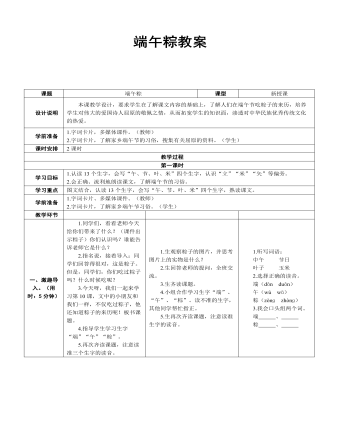
《端午粽》教案
1.生认真倾听老师范读,边听边思考:课文有几个自然段,写了有关粽子哪些方面的内容呢? 2.生回答老师提出的问题。3.生读第一自然段,并思考这一段的主要内容。 4.全班交流第一自然段的内容。5.观察田字格中生字“午”、“节”的笔顺和所占的位置,边描红,小组内讨论该注意的问题。6.展示并交流书写作品。7.生自读第2自然段,边读边完成老师提出的任务,组内讨论交流。8.全班交流:第2自然段主要写了端午粽哪些方面的内容呢?9.生朗读以下词语:箬竹叶糯米枣清香又黏又甜10.朗读第2自然段,在老师的引导下,准确找出相关句子:(1)外婆的粽子是用这些材料包成的:粽子是用青青的箬竹叶包的,里面裹着白白的糯米,中间有一颗红红的枣。(2)煮熟的粽子,清香扑鼻:外婆……一股清香。(3)外婆包的粽子味道美极了:剥开粽叶,……又黏又甜
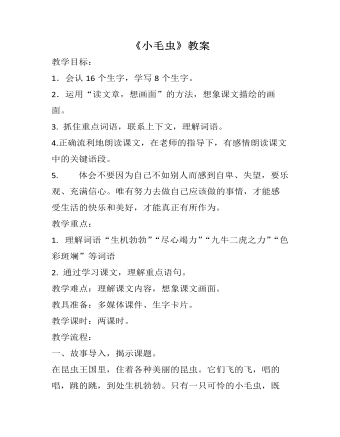
《小毛虫》教案
细读课文,理解内容。(一)学习课文第一小节。1.(出示:一条小毛虫趴在一片叶子上,用新奇的目光观察着周围的一切:)(强调冒号)师读。这个一切是指——2.?“新奇的目光”是一种怎样的目光?你能换一个词语说说吗?(近义词:好奇)3.请几位同学来为大家读读这句话,要求读出“新奇”的感觉。4.小毛虫在观察。它难道不想加入昆虫们的活动可是……(出示:只有它,这个可怜的小毛虫,既不会唱,也不会跑,更不会飞。)读了这句话,你觉得小毛虫怎么样?(可怜——【板书:可怜】)那它是怎么移动的呢?读一读课文的第二小节。(二)学习课文第二小节。1.(出示:小毛虫费了九牛二虎之力,才挪动了一点点。当它笨拙地从一片叶子爬到另一片叶子上时,它觉得自己就像是周游了整个世界。)小毛虫给你留下了什么印象?从文中找一个词回答。(笨拙)【板书:笨拙】
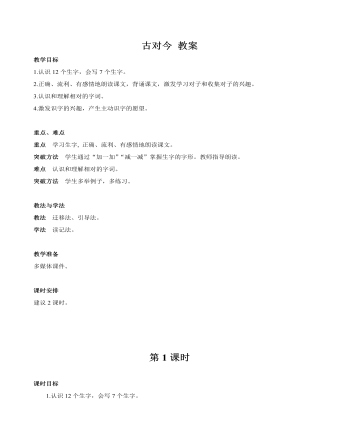
《古对今》教案
初读课文,自主识字1.学生自由读课文。师:同学们,课文中描写了大自然的美丽景色,你们想不想读?在读之前老师有个问题想问大家,在读的过程中遇到不认识的字怎么办?(借助拼音,问同学或者老师)学生自己试着读课文。2.教师指名轮流读课文。教师指名以开“小火车”的形式读课文,每人读一小节。其他学生认真听,充当小评委。3.教师用多媒体课件出示课文,其中生字用红色标记。教师组织学生齐读课文。师:读完课文后你们发现了什么?生:这些红色的字就是我们这节课的生字。4.教师指导学生认识生字。
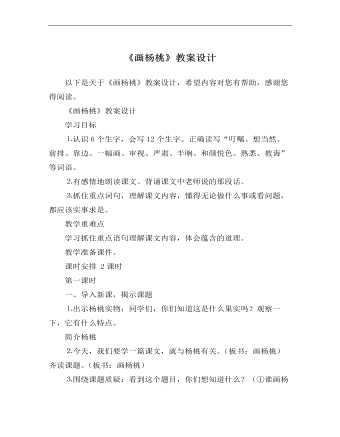
《画杨桃》教案
检查预习,理清层次 ⒈指读生字词 ⒉你理解了哪些新词意思?怎么理解的?(交流) 联系上下文理解词语 想当然:凭主观想象,认为事物应该是这样。联系课文内容,父亲经常叮嘱“我”,看见一件东西是什么样的,就画成什么样,不要凭主观想象,画走了样。 ⒊指读课文,交流:本文讲的是一件什么事?(这是一篇精读课文,主要讲的是图画课上练习画杨桃时发生的事情。) ⒋划分层次 第一段(1):略写父亲教导我画画要实事求是。 第二段(2—18):具体地叙述我把杨桃画成五角星时发生的事 第三段(19):写父亲和老师的教诲使“我”一生受用。 用连接段意法概括课文主要内容:先略写父亲教导我画画要实事求是,接着具体地叙述把杨桃画成五角星时发生的事,最后写父亲和老师的教诲使“我”一生受用。
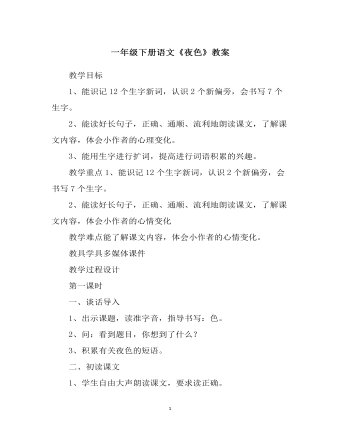
《夜色》教案
体会胆小 1、指名朗读,思考回答:这一小节主要写了什么? 2、同桌讨论:应该用什么样的语气和音量读? 3、展示朗读,相机评价。 4、交流:小作者胆小到什么程度?用句式说话:因为……所以…… 5、理解第一行和第四行。并造句:一……就…… 6、师生合作读第一小节。 体会勇敢 1、指名朗读,思考回答:这一小节主要写了什么? 2、同桌讨论:应该用什么样的语气和音量读? 3、展示朗读,相机评价。 4、讨论:小作者为什么有这么大的变化?句式练说: 白天,他看到花草(),夜里,他看到花草也(); 白天,他看到小鸟(),夜里,他看到小鸟(); 白天,他看到(大树)(),夜里,他看到(大树)()…… 5、师生合作读第二小节。

